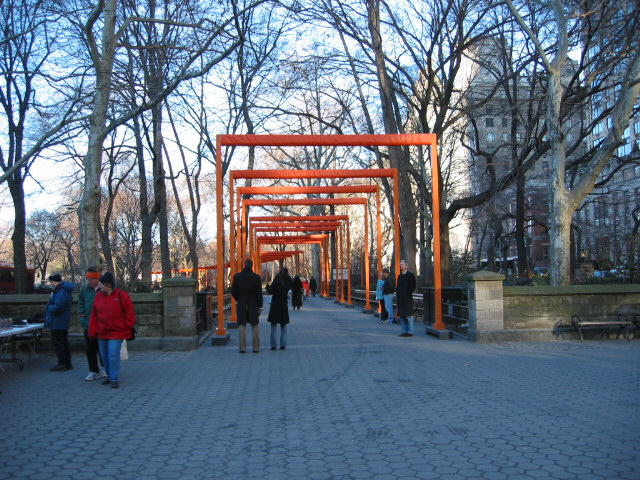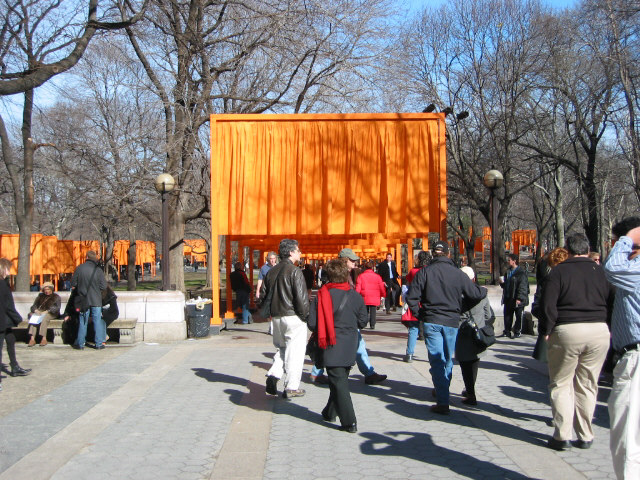The Gates will be a golden ceiling creating warm shadows. When seen from the buildings surrounding Central Park, The Gates will seem like a golden river appearing and disappearing through the bare branches of the trees and will highlight the shape of the footpaths. The luminous moving fabric will underline the organic design of the park, while the rectangular poles will be a reminder of the geometric grid pattern of the city blocks around the park. --Christo and Jeanne-Claude
 |  |
The official title -- "The Gates, Central Park, New York, 1979-2005" -- refers to the artists' conception of the idea 26 years ago. Celebrated artists Christo and Jeanne-Claude unfurled THE GATES, PROJECT FOR CENTRAL PARK 1979-2005, on February 12. On Friday, February 11 at the top of the gates, were bundled up, 1,089,882 square feet of saffron fabric. On Saturday, February 12 the cocoons were opened to reveal fabric panels hanging seven feet above the ground.
The Gates Project is not just a great Art Exhibit; it is an opportunity for teachers to integrate Art with Mathematics and Science.
 |  |
What are all those numbers about?
5,290 US Tons of steel (4,799 Metric Tons) (10,580,000 pounds) for 15,000 specially designed steel footing weights, varying between 611 and 837 pounds each, according to the width of the gate, (278 - 379 Kg.). The weights are resting on the hard surface of the walkways. There are no holes in Central Park.
315,491 linear feet (60 miles) (96.5 Km.) of Vinyl tube, 5 inch x 5 inch square, (12,7 x 12,7 cm.) for each gate: 2 vertical 16 feet long (4,87 meter), and one horizontal (varying between 6 and 18 feet, because the width of the walkways varies) 15,000 specially designed, recyclable, cast aluminum upper corner reinforcements which hold together the 2 vertical poles to the horizontal pole. 15,000 base anchor sleeves. Which are bolted to the steel footing weights
. 15,000 (1/2 inch x 8 inch x 8 inch) (1.27 x 22,8 x 22,8 cm.) steel leveling plates. The leveling plate are between the base anchor sleeve and the steel base.
165,000 bolts and self locking nuts. (7,500 x 22)
15,064 (8 x 8 x 8 inch) (22,8 x 22,8 x 22,8 cm.) Vinyl leveling plate covers, to hide the bolts
. 116,389 miles (187,311 Km.) of nylon thread in saffron color and specially woven into 1,092,200 square feet (98,298 square meters) of recyclable, rip-stop fabric were cut and sewn into 7,500 fabric panels of various widths. 46 miles (74 Km.) of hems.
Do you know your conversions Metric <> US?
What keeps those gates from flying off?
 | 7500 Steel Bases The dimensions of the base shown is: 48" (length)x 12"(depth) x 6"(height), Each base is actually made of three blocks (see image).The top solid block is 48" x 12" x 3". The two feet are each 6" x 12" x 3". |
The above base was made from large plates of steel. A total of of 809 steel plates were manufactured at the ISG mill in Coatesville, PA.
The ORIGINAL LARGE plates of steel were each 12,252 pound (5,557 kg). Their dimensions were 3" (7.62 cm.) thick, 60" x 240" (1.52 x 6.09m)
What is the weight of the base shown above?
How to proceed:
There are several ways to approach this problem; we present two methods here. See if you can come up with other methods. You are working with very large numbers and will most likely need a calculator.
Method I:
USE THE VALUE FOR THE DENSITY OF STEEL IN THE FORMULA:
| D= Mass/Volume |
THE VOLUME OF THE TWO SIDE BLOCKS IS (do not use coma's): (The two feet are each 6" x 12" x 3")
IF DENSITY =MASS/VOLUME THEN:
THE MASS OF BASE SHOWN ABOVE IS:
THE WEIGHT OF BASE IN POUNDS IS (ROUND OFF TO THE NEAREST POUND):
Method II:
USING RATIOS AND PROPORTIONS --PROPORTIONAL REASONING
MASS
OF ORIGINAL LARGE BLOCK | MASS
OF BASE SHOWN | |
| ______________________________________ |
= | __________________________________ |
VOLUME
OF ORIGINAL LARGE BLOCK | VOLUME
OF BASE SHOWN |
THEN SOLVE THE PROPORTION FOR THE MASS OF THE BASE.
SUGGESTED SITES:
http://www.christojeanneclaude.net/tg.html
See live Web cam for Central Park Conservancy-Harlem Meer Webcam page-
What is Steel? The Different Types of Steel.